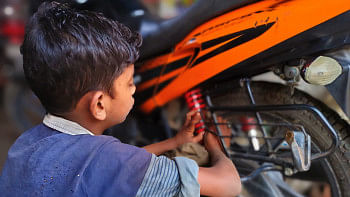Investment in children will give lifelong returns

Investing in the well-being and development of children is not just a moral obligation; it is a fundamental necessity for any nation aspiring to thrive in the long run. By investing in children, governments lay the groundwork for a brighter future where all children, regardless of their background, have equal opportunities to flourish. Investing in the early stages of human development also has a higher return, which gradually decreases over time. It generates the highest return since early learning facilitates later learning and helps develop skills as children grow into adults. Evidence shows that every additional dollar invested in quality early childhood development programmes yields a return of $6-17.
Moreover, it is rational from an economic perspective. Data shows that a child's additional year of schooling increases their future earnings by about 10 percent. There is also a strong correlation between the ability to read and write and reduced child marriage for girls. Only eight percent of literate girls in South and West Asia are married off as children, compared to almost 25 percent of illiterate girls from the same region.
In recognition of the significance of investment in children, many countries have embraced the concept of a national child budget – a dedicated financial plan aimed at ensuring children's welfare and holistic development. Governments affirm their dedication to providing quality healthcare, education, social protection and other essential services by allocating specific funds for child-related initiatives. It underscores the belief that children deserve the best start in life and lays the foundation for a fair and inclusive society. It also plays a pivotal role in breaking the cycle of poverty.
Considering children comprise about 40 percent of the population and our window of accessing our demographic dividend is going to close in a few years, we must meaningfully allocate more resources for children's development.
Like many other countries, Bangladesh is also committed to investing in children's welfare, as is articulated in the current national five-year plan (8FYP) for 2020-2025. Indeed, the government reported child-focused budgets from FY2015-16. The children's budget has doubled since its inception in FY2019-20; however, the aim to allocate at least 20 percent of the total national budget for children has not been achieved yet. Since the onset of Covid-19, the government did not publish child budget reports in the last three consecutive years, and FY2023-24 is no exception. A Save the Children study estimated that about 14.9 percent of the FY2023-24 budget is planned towards child-related activities based on the latest available coefficients. The estimate includes allocations that directly benefit children and also indirect allocations that support parents, teachers, social service providers and other duty-bearers who are involved in child-focused activities. Considering children comprise about 40 percent of the population and our window of accessing our demographic dividend is going to close in a few years, we must meaningfully allocate more resources for children's development.
Higher public expenditure in the social sectors provides greater benefits to children. Education spending has been hovering around 1.5-2 percent of our GDP for over a decade, while the government aspires to raise the share to three percent by FY2024-25. In contrast, Bhutan has been persistently spending over 5.5 percent of its GDP on education. India has been spending about three percent of its GDP on education since 2019. According to an Implementation Monitoring and Evaluation Division (IMED) report, regrettably, the Ministry of Primary and Mass Education and the Ministry of Education were the two worst performers in FY2021-22 in terms of spending the funds they received from the Annual Development Programme (ADP), among the 15 ministries or agencies that received the highest allocations.
Health sector allocations do not reflect any optimistic view either. The sector's budgetary share has been less than one percent of GDP for over a decade, compared to India's 2.2 percent investment. Bangladesh's out-of-pocket health expenditure is about 74 percent of total spending – one of the highest in the world. It is also evident from the past trend that we put little emphasis on early childhood care, including balanced nutritional intake. The Bangladesh Demographic and Health Survey 2022 report evinced a deteriorating trend in severe acute malnutrition (SAM). In FY2023-24, the health sector comprised only five percent of our national budget. The lesser the investment, the lesser the scope to address child health-related issues.
Likewise, the social protection budget is also not on par. A sizeable portion of Social Safety Net Programmes (SSNP) covers the government pensioners' scheme and freedom fighters' allowances. Evidence shows that the global average spending on social protection for children aged 0-14 years is about 1.1 percent of GDP, while for low-income countries, the figure is only 0.1 percent. In Bangladesh, the scenario is no different. Children's share for this is even less, on top of a small percentage of beneficiary coverage. Socially disadvantaged children like street children, children with disabilities, and child labourers received little attention in the SSNP budget.
Overall, the budgetary allocation specifically earmarked for children-related programmes and initiatives in Bangladesh is insufficient to meet the diverse needs of children across the country. Despite making some progress, the proportion of the budget allocated to children-focused programmes does not fully address the magnitude of their challenges. The programmes are not designed to reach the most marginalised children from diverse backgrounds. Their issues are not being prioritised adequately in national budgets in the face of competing priorities.
To fulfil the initial target to raise the child-focused allocations to 20 percent of the national budget, the resources required will be grossly Tk 150,000 crore for FY2023-24. Addressing these challenges requires concerted efforts from government agencies realising the importance of investing in children, strengthening children's representation in decision-making processes, and prioritising long-term socioeconomic benefits. Government bodies, civil society organisations, and individuals must advocate for children's rights and well-being, ensuring that they receive a fair share of national budgets, and a separate national reporting of child budgets will take place to track the overall spending on children efficiently.
Sara Hanan Chowdhury is an officer at Save the Children Bangladesh. She can be reached at [email protected]

 For all latest news, follow The Daily Star's Google News channel.
For all latest news, follow The Daily Star's Google News channel. 









Comments